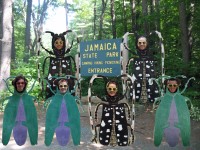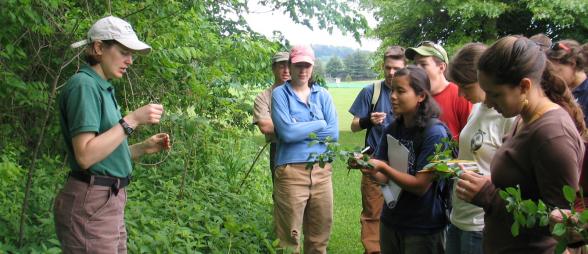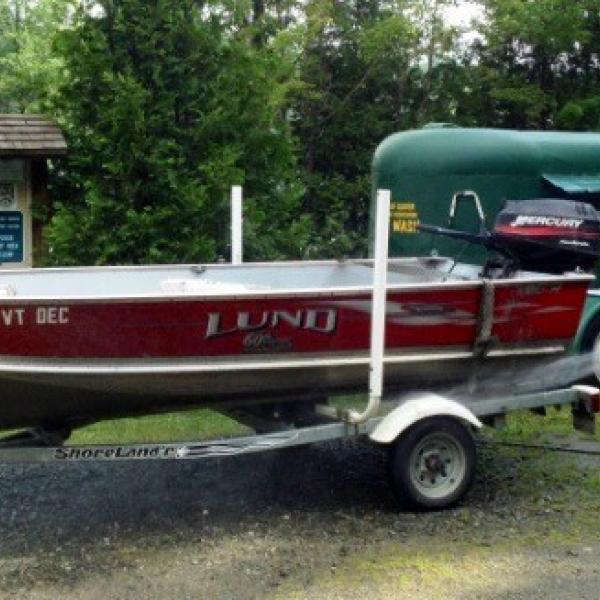Spread the word!

Having a good outreach strategy can make a huge difference in the prevention of invasive species. It was the incredible public outreach and community involvement that made it possible for Chicago to eradicate their infestation of Asian longhorned beetle.
On this page you will find an assortment of education and outreach material specific for forest pests, invasive plants, and aquatics. If you do not find what you are looking for on this page, be sure to also check out the Resource Hub.
Forest Pest Outreach Opportunities
- Organize a Tree Tagging Event
-
Unfortunately, most people cannot identify ash trees and therefore have no idea of what’s at risk until it’s too late. Tree tagging events have been organized in New York, Indiana and other Midwestern states as an effective way to raise awareness about the threat of the Emerald Ash Borer (EAB). Print your own tree tags.
- Complete an Ash Tree Inventory
-
Tree inventories can be as simple as walking through your woods for ten minutes or examining trees along your street while driving your car. They can also be detailed and expansive. Guidelines and worksheets for completing an ash inventory.
- Give a Talk or Host a Movie Screening
-
Public presentations are an excellent way to spread the word about forest pests. You can find Powerpoint presentations, videos, posters, handouts, and more in the Resource Hub. These are available for you to use and modify, as you see fit.
If public speaking isn't your cup of tea, you can contact UVM Extension's Forest Pest Outreach Coordinator Ginger at Ginger.Nickerson@uvm.edu.
- Write an Article
-
Share what you've been up to or encourage others to take action. Writing articles, whether it is for a newspaper, blog, or a post on Facebook is a quick and easy way to spread the word. Here are some examples to inspire you:
Aquatic Invasive Species Opportunities
Check out the Resource Hub for presentations, videos, posters, handouts, and more. For more information, contact the Vermont Department of Environmental Conservation's Aquatic Invasive Species Management Coordinator, Kim Jensen at Kimberly.Jensen@vermont.gov.
Terrestrial Plant Outreach Opportunities
Invasive plants are too big an issue to be any one person’s problem -- one of the most effective ways to address invasive plant management is through locally-organized responses. Community involvement is a necessary component of any successful response to invasive plants because individuals are the eyes – and often the feet– on the ground, and can respond to invasive plants quickly, continually, and effectively.
There are a few ways to get involved in a local invasive plant management effort: you can volunteer for an existing program, you can link up with a regional CISMA (check out #4 on this page), or you can organize a response in your own community.
- Project How-To Guide: This guide developed by The Nature Conservancy Vermont, provides resources that are helpful for whether you’re just starting out or interested in learning more about outreach.
- Working with Volunteers of All Ages: Whether working with young people, school groups, teens, or adults, there are great resources available to help make it a rewarding experience for all involved.
- Training Community Leaders: Looking to maximize your groups’ outreach efforts but have limited time or capacity? Consider training community leaders, who can provide local leadership, motivate neighbors to action, and be the champion of this cause in their community.
- CISMAs: Cooperative Invasive Species Management Areas are a great way for communities to respond to invasive species in a regional, collaborative way.
- Problems and Solutions: Check out the case studies below that include problems encountered and solutions discovered by other Vermonters managing invasive plants.
The Resource Hub also has great information including handouts, Best Management Practices, and more.
1. Project how-to guide
Find an overview 'how to guide' here, or download the chapters of the Developing Invasive Plant Outreach and Management Projects: A Guide for Vermont Communities and Conservation Organizations via the links provided below.
- Planning Your Project
- Recruiting and working with volunteers
- Organizing and executing a workday
- Getting the word out
- Working with governments and schools
2. Working with Volunteers of All Ages
Whether working with youth, school groups, teens, or adults, there are great resources available to help make it a rewarding experience for all involved.
- Schools and Informal Education
-
US Forest Service Non-native Invasive Species Learning Kit - This is a four part kit developed by the US Forest Service's Eastern Region, and includes information and activities to educate preschool to adult groups
Youth Volunteer Guide - This guide is the result of years of experience planning and hosting invasive plant management workdays for youth of all ages in school, after-school, and camp settings. Here, you can view or download the comprehensive guide as a single resource and/or by topic.
3. training community leaders
Perhaps you're wanting to create a lasting system of volunteerism and outreach around the issue of invasive plants in your community, and looking for examples. The Vermont Department of Forests, Parks & Recreation's Invasive Plant Program have had so much fun and success working with our Forest Hero! Network that we wanted to make our materials available to anyone interested.
You can find these resources all here, including: sample trainings and materials, schedules, scripts, and suggestions based on our experiences.
We wish you the best of luck, and thank you for helping even more people get outside to learn, get involved, and make a difference.
- Training Materials
-
Trainings should be well organized, informative, and fun. Whether you're looking to host something online or in-person (or both!), you'll find sample planning checklists, day-of agendas, and activities. You'll want to decide on a core goal and mission for your volunteers. Our network focuses on teaching about the science of invasive plants, how to organize and support local efforts to address invasive plants, and provide tools for motivating neighbors to engage in invasive plant management. Whatever your focus, make it approachable, positive, and engaging.
- Planning Checklist for Trainings:
- Day-of Agenda:
- Instructions for Example Training Activities:
- Learn and Teach ID
-
Learning to identify (and teach about!) invasive plants is largely a matter of practice and having reliable resources to learn from. Below you'll find links to support both!
- Network Resources
-
Often, the hardest part of organizing a community response to invasive plants is helping people figure out what to say. We found keeping an online resource library for our volunteers to be helpful.
Through working with our network of volunteers, we found these ideas around engagement and messaging helpful. And to help with more technical questions, please also find below the formal Quarantine & Watch List of invasive plants in Vermont, and a few examples of best management practices.
- Communication Resources
- Technical Resources
- Quarantine & Watch List
- Examples of Best Management Practices
- New York: A Landowner's Guide to Invasive Knotweed Control
- New Hampshire: Preventing the Spread of Japanese Knotweed
- Great Lakes Phragmites Collaborative: Management of Phragmites, Common Reed
- Connecticut: Movement of Fill, Topsoil, Gravel, Mulch, and Equipment
- Great Lakes Collaborative: Physical Removal of Woody Invasive Plants
4. Cooperative Invasive Species Management Areas
Invasive plants are a landscape-scale problem (and plants don't recognize borders or fences), so it can be helpful to bring other people and organizations on board to work together.
- What is a CISMA
-
A Co-operative Invasive Species Management Area, or CISMA, is a partnership among local organizations working to manage invasives in a particular area through outreach, prevention, and treatment. Organizations that are part of a CISMA can work together to share resources and collectively be more effective in their work. To learn how to create a CISMA in your community, check out the Midwest Invasive Plant Network, which hosts a variety of resources on creating a cooperative weed management area.
If you are an existing CISMA that works on lands in Vermont, please contact the Invasive Plant Program so we can share your website or contact information here.

- Vermont CISMAs in Action
-
- Batten Kill Watershed CISMA
- Southeast VT CISMA
- Upper CT River CISMA
- Upper White River CWMA
- Orleans County CISMA
While not a CISMA, Black River Action Team deserve mention for their great work at Early Detection, Rapid Response!
5. problems and solutions
Invasive plants are a common problem, and it can be useful to learn about what other communities have done in response.
- Management Case Studies

